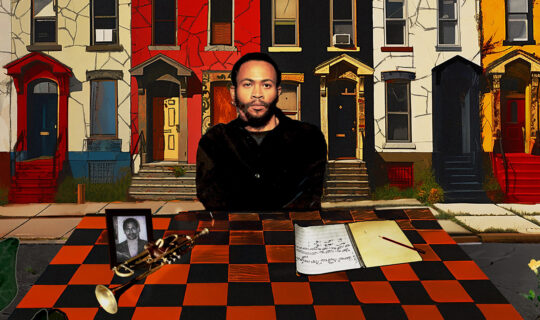January 6, 2013
On Sonny’s Crib, the second Blue Note album from under-sung hard bop pianist Sonny Clark, the arrangements seem to be saying something very specific. For each of the LP’s standards, Clark appoints a single player to handle the melody: Trumpeter Donald Byrd tackles “With a Song in My Heart”; “Speak Low” is spoken by tenor saxophonist John Coltrane; and “Come Rain or Come Shine” is handed off to trombonist Curtis Fuller. But on the album’s two originals, “Sonny’s Crib” and “News for Lulu,” the script is flipped—Clark’s hornmen play the clear, down-home heads together. If there’s a message here, perhaps it’s this: Standards need little more than an individual spin to be heard, but it takes a village to properly belt out Clark’s tunes. And so it’s this juxtaposition of solitude and unity that’s at the core of Sonny’s Crib.
Recorded on September 1, 1957, and also featuring bassist Paul Chambers and drummer Art Taylor, Crib begins with that version of “With a Song in My Heart,” taken at breakneck speed. After conjuring up the melody over tiny flourishes from Fuller and Coltrane, Byrd jumps right into a winding, sure-footed solo, one low on space but not at the expense of thought or lyricism. Commencing with a few moments of lush solo piano, Kurt Weill’s “Speak Low” is brought to life by Coltrane’s singing sax and Chambers’s propulsive low end, the bassist alternating between walking and outlining the head. Clark’s solo on “Speak” is a rolling, rambling essay that stretches from bop to blues and back, the leader adding pinches of dirt and grease where other pianists might have waxed or polished.
“Come Rain or Come Shine,” the album’s only ballad, crawls along to the tune of Fuller’s sweet, lazy trombone and Taylor’s understated brushwork, not to mention Chambers’s sparse plodding, which comes as a relief after the relentless walking of the previous two pieces. Here, at a snail’s pace, Clark improvises better than he does anywhere else on the album; granting himself what likely felt in the moment like all the time and space in the world, he accesses a sly, soulful well of ideas, disregarding bebop’s technique-driven competitive streak. For the last thirty seconds of the tune, Chambers gets into some arco textures, bowing the listener back home.
With standard time out of the way, the members of the Clark sextet unite in a deeper way to explore a pair of the leader’s originals. A blues with a bridge, “Sonny’s Crib” is the first tune on the album to feature all three horn players on the head. With its nearly 14-minute running time, “Crib” is also the biggest jam of the session, featuring solos from every band member except Taylor; Chambers’s loose, bubbling improvisation is thrilling, though no more so than, say, Clark’s long, chiming dispatch or Fuller’s ebullient, blustery appeal. Named for Clark’s dog, a German shepherd mix, “News for Lulu” opens on a nervous, vulnerable ostinato shared by bass and piano, and complicates things with a rising, inquisitive three-horn melody. Clark takes the first solo, as if to remind the listener that, despite the powerful group dynamic cultivated by the end of the LP, this is the pianist’s show. Later in the tune, Coltrane threatens to melt Rudy Van Gelder’s mics with a fiery tale of pain and devotion.
Appended to the 1998 CD reissue, three alternate takes tell stories of their own. The rejected version of “With a Song” is a more frenzied affair than the album version, with eight bars of hectic solo piano to start things off and a wilder solo from Coltrane. Notable, too, is a new section where each of the horn players trades fours with Taylor; funnily, in the original liner notes, Leonard Feather writes, “An unusual feature of this session—unusual, at least by the standards of contemporary customs on small combo record dates—is that there are no ‘fours’ at any point.” Also, if the piano solo from the alternate take of “With a Song” and the trumpet and piano solos from “Speak Low” sound familiar, it’s not because of any sort of planning on the players’ parts; these improvisations were snagged from the alternate takes and spliced into the classic versions.
Crib is also a snapshot of Coltrane during an important transitional period. In April, he had been fired from Miles Davis’s group; in May, he quit heroin for good; and in the middle of July, he joined Thelonious Monk’s quartet, a situation that would last until the end of the year. So it was as a clean-living disciple of the High Priest of Bop that Coltrane descended on Van Gelder’s New Jersey studio that day, to riff with Clark, Byrd, Taylor, Fuller, and Chambers. Exactly two weeks later, Coltrane returned, with Fuller and Chambers in tow, to record the Blue Note classic Blue Train. And that album came not just on the heels of Crib, but also following appearances by Coltrane on Blue Note sessions led by Chambers and fellow saxophonist Johnny Griffin.
Sonny Clark’s music has had an undeniable impact on jazz musicians the world over, but interestingly, some of its strongest support has come from jazz’s avant-garde community. In 1985, pianist Wayne Horvitz assembled the Sonny Clark Memorial Quartet, which issued one album, Voodoo, the following year. Also featuring bassist Ray Drummond, drummer Bobby Previte, and savage altoist John Zorn, the quartet produced more-or-less faithful versions of Clark compositions, including “Sonny’s Crib,” which concludes Voodoo. And in ’88, the trio of Zorn, guitarist Bill Frisell, and trombonist George Lewis released News for Lulu, a disc of hard-bop tunes that includes “Sonny’s Crib” and the title track. More News for Lulu, a second outing from the triumvirate, emerged in ’92; that disc also includes a version of “News for Lulu.”
Clark, who lost his battle with heroin in 1963, was, in the words of Feather, a “short, sad-eyed, pensive little man who comes alive when he sits at the piano.” On Sonny’s Crib, one can hear Clark springing to life, and the feeling is mutual.
Photos courtesy of Mosaic Images




